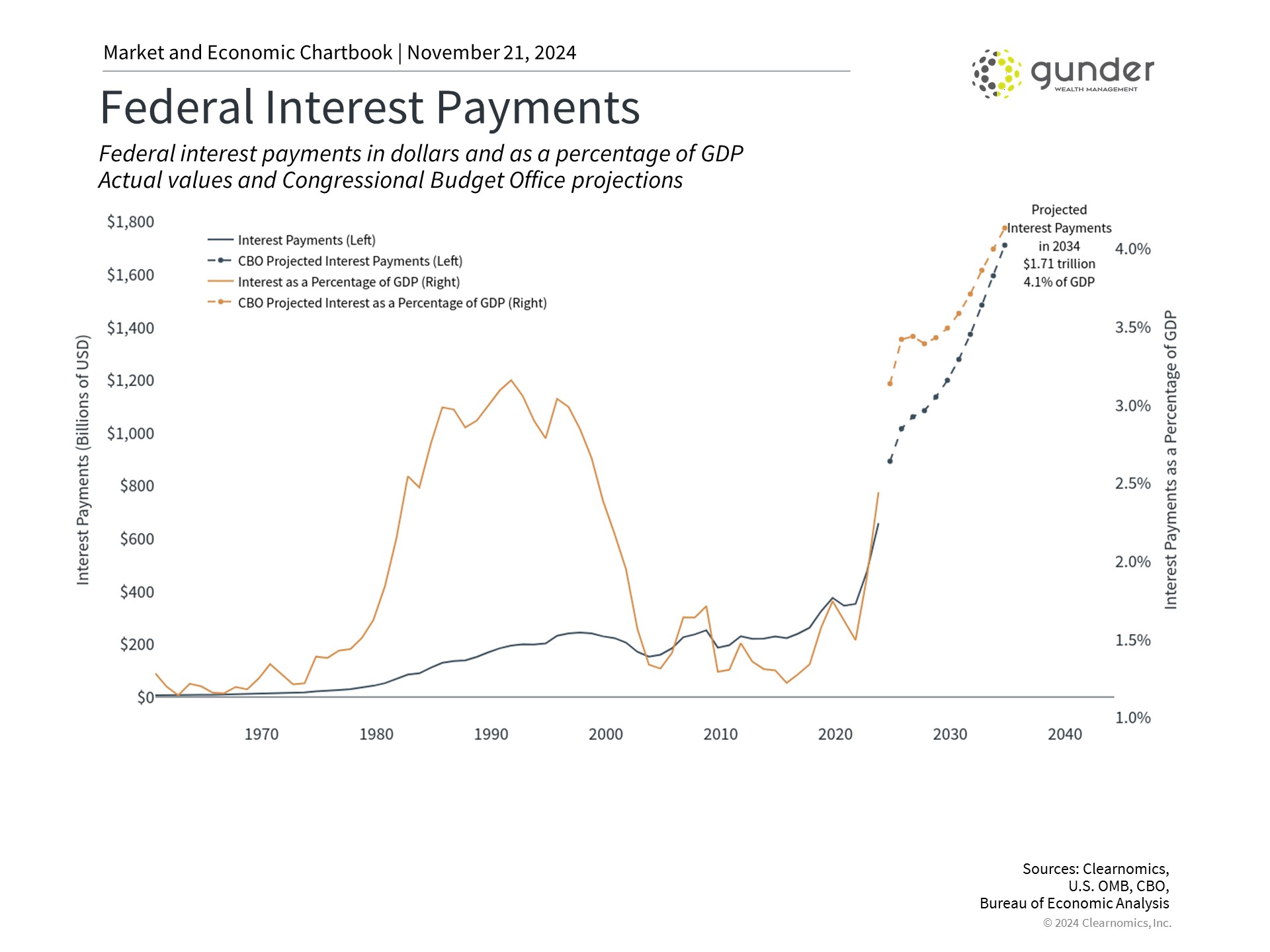
How does the $36 trillion national debt impact investors?
According to the U.S. Treasury, the national debt is quickly approaching $36 trillion, which fuels concerns among investors and economists alike. This means the federal debt has nearly quadrupled since before the 2008 global financial crisis and has grown yearly since 2001. This exponential growth fuels the fire when debating budget deficits, the debt ceiling, government shutdowns, stimulus bills, and more.
With the election now behind us, the large and ever-growing national debt is mounting in importance. How can investors put government spending in perspective and focus on what drives markets in the long run? It’s important to distinguish between what matters as taxpayers vs. investors. Many of us have strong personal and political views on government spending and taxation and what it may mean for the country over the coming generations.
These concerns, however, should be distinguished from whether the federal debt directly (or indirectly) impacts the economy. Without diminishing the significance of this topic, let’s remember that market returns have soared over the past two economic cycles – our advice: avoid overreacting with your investments at the expense of your long-term financial plans.
Let’s not forget that the economy has also doubled since 2008. Although it’s still unjustified, the national debt now represents 120% of GDP. However, this includes debt the government owes to itself through Treasuries held by government agencies. Excluding these, the government debt is 95% of GDP. This is still sizable, and the latest jump is due primarily to pandemic-era stimulus.
How Did This Happen?
Two words: budget deficits! Budget deficits occur when the government spends more than it collects in taxes, which adds to the total debt.
While tax revenues tend to increase as the economy grows (even without raising tax rates), they are consistently outpaced by government spending. The shortfall is funded by government borrowing through the issuance of Treasuries. Investors, institutions, and other countries buy these Treasuries and, in effect, fund the federal government.
The current deficit of around 6% of GDP is by no means small. Still, there have been many periods across history – primarily during economic downturns and wars – when the government was forced to spend. History shows that, over time, deficits improve as the economy stabilizes, even if they don’t turn into surpluses.
Unfortunately, deficit spending is likely not going away, with neither political party focusing on the issue. The accompanying chart shows that left unchecked, government projections suggest that interest payments on the debt alone could rise to $1.71 trillion in ten years.

Fact Check
- The government or U.S. citizens hold about two-thirds of the national debt.
- Other countries hold the rest, with China owning about 2.2% (although this proportion has declined).
Many investors worry that growing debt levels mean that Treasuries could be less attractive in the future. In an extreme case, this could hamper the government’s ability to roll its debt, leading to skyrocketing interest rates or weakening the dollar’s standing as the world’s reserve currency. Ultimately, many worry that the U.S. could lose its position in the global economy.
While possible, it seems unlikely, even with increased enthusiasm for dollar alternatives such as cryptocurrencies and gold. This has been a concern among economists for many decades. And yet, when the global economy faces distress, investors and governments turn to the U.S. as a safe haven. In 2011, for instance, when Standard & Poor’s downgraded the U.S. debt during the fiscal cliff standoff, investors didn’t sell their Treasuries – they rushed to buy more. Counterintuitively, this is because U.S. debt securities are still the standard for stable, risk-free assets in the world despite these challenges.
Closing Thoughts
Finally, and perhaps most importantly, markets have done well regardless of the exact level of government debt and taxes over the past century. Ironically, the best time to invest over the past two decades has been when the deficit has been the worst. These periods represent times of economic crisis when the government is engaging in emergency spending, which tends to coincide with the worst points of the market. And while this isn’t exactly a robust investment strategy, it underscores the importance of not overreacting to fiscal policy in one’s portfolio.
The federal debt is a complex and controversial topic. As with many heated issues, investors should calm their concerns and not react with their hard-earned savings or investments.
Feel free to connect with us here to further address your concerns about how the national debt may impact your investment portfolio.
Please consult with your financial advisor and/or tax professional to determine the suitability of these strategies. All views, expressions, and opinions in this communication are subject to change. This communication is not an offer or solicitation to buy, hold or sell any financial instrument or investment advisory services.
